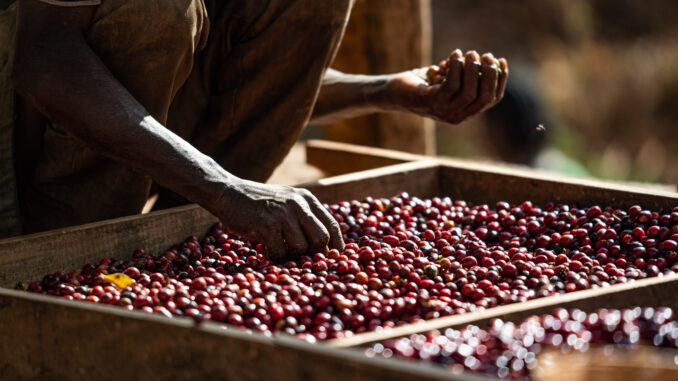
Continuing our series on coffee processing, we learn about carbonic maceration—a unique, newer processing method.
BY TANYA NANETTI
SENIOR ONLINE CORRESPONDENT
Photos courtesy of Cafe Imports
Editor’s note: Check out more entries in our “Understanding the Process“ series here.
The rise of the specialty-coffee scene has helped many people understand that talking about coffee as something that always tastes the same—usually dark and bitter, with no distinctive flavor—is reductive. Flavor notes can vary from hints of dark chocolate to candy peach to jasmine. These depend on many factors, including coffee varieties, origin, processing, and roasting style.
Carbonic maceration is among the many interesting coffee processes—and one that was developed more recently. The process involves the use of carbon dioxide to soften the tissue of the coffee fruit. So what exactly is carbonic maceration?

Carbonic Maceration Explained
Taya Brown, Ph.D., coffee production researcher and educator at Cafe Imports, can help us understand more about it.
Carbonic maceration, Taya explains, is a form of anaerobic processing. The term is borrowed from a winemaking process where bunches of grapes are fermented in tanks with their stems. Carbon dioxide is then pumped directly into the tanks. ”Including skins, seeds, and plant material under these particular environmental circumstances is a way to infuse the wine with tannins and other compounds existing in those tissues, but without having these impart their sometimes unpleasant flavors,” Taya says. ”Essentially, it’s a way to increase and improve the flavor of what might otherwise be less flavorful and enjoyable wines.”
But how exactly does it work when we talk about coffee?

How It Works
The process is very similar for coffee, says Taya. “We must remember that comparisons between wine and coffee break down pretty quickly—one of the main differences is that the product we consume in wine’s case is the fruit and juice that undergoes the fermentation. In coffee it’s the seed we’re after, and that seed goes through a lot more than wine does before we drink it. The coffee seeds/beans sit through fermentation of the fruit’s flesh … (then are) cleaned of that fruit, dried, and stored, then roasted and brewed before we ever taste it. The current definition of carbonic maceration in coffee refers to whole cherries sealed in a container with Carbon Dioxide (CO2) actively pumped into it. CO2 creates pressure and pushes oxygen (O2) out, resulting in an anaerobic environment. CO2 is thought to favor a different metabolic force than open-air fermentation, and also may reduce oxidation of fruit and seed tissues.”
While factors such as time and temperature can help create a range of different flavors, often carbonic maceration coffees have “intense flavor profiles, with boozy and cooked fruit flavors,” Tanya says. Of course, some of them are sweeter, and some more acidic. If things don’t go right, “they also run the risk of astringency, dryness, and bitterness,” she adds.
Risk and Rewards
Taya shares her point of view on the pros and cons of carbonic maceration.
“One thing to appreciate about carbonic maceration is the ability to control variables and target specific outcomes for coffees. Anaerobic fermentation offers a way to control the environment the coffee sits in during fermentation and, with the introduction of CO2, carbonic maceration can offer yet another level of control. However, to process coffees this way requires tanks that can be sealed, one-way valves to let the O2 out and release pressure as CO2 builds up.” These tanks can be a big investment, so they may not be within reach for all producers.

Taya cautions that carbonic maceration requires an intimate understanding of the variables involved and a view of the end goals. One of the most important necessities is the ability to cup. ”It’s very difficult for producers to experiment, and to invest in specialized equipment if they can’t cup their experiments,” Taya says. ”Many producers do have access to cupping labs, but many in the world do not. Without the ability to know what the outcomes are, adding CO2 really doesn’t offer the benefit of a controlled variable—you have to have a short feedback loop to understand flavor and quality shifts as investments are made and new processing steps are trialed. While it’s exciting to have new terminology, new flavor profiles, and for producers to have new avenues of value addition and differentiation to explore, new processes also require investment and carry a level of risk.”

Taya’s Takeaway
As a final note, Taya adds a clarification on terminology when it comes to the carbonic maceration process.
“One thing to note is that, just like with other forms of anaerobic processing, carbonic maceration is just one step and can be combined with several other steps, along with all major processing types—washed, honey, and natural,” Taya says. “In my opinion, we do a disservice to call a coffee ’an anaerobic’ or ’a carbonic maceration,’ because we’re then ignoring any other steps a coffee went through. It would be more accurate to say ’a natural/honey/washed coffee fermented in an anaerobic environment for X number of hours.’”
ABOUT THE AUTHOR
Tanya Nanetti (she/her) is a specialty-coffee barista, a traveler, and a dreamer. When she’s not behind the coffee machine (or visiting some hidden corner of the world), she’s busy writing for Coffee Insurrection, a website about specialty coffee that she’s creating along with her boyfriend.




